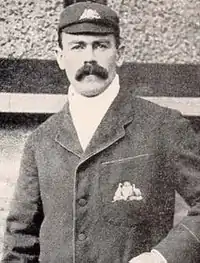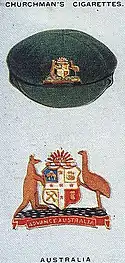Baggy green
The baggy green is a cricket cap of dark myrtle green colour, which has been worn by Australian Test cricketers since around the turn of the twentieth century. The cap was not originally baggy as evidenced by photographs of early players. The cap has long been a symbol of national pride in Australia,[1] and was described by the chief executive of the MCC as the "most famous cricket cap in the world".[2]


Right: Steve Waugh wearing his well-worn baggy green cap in 2002
While respect for the baggy green cap has always been very high, it has grown in stature since the 1990s, chiefly due to the efforts of captains Mark Taylor and Steve Waugh. Waugh regularly expressed his belief that the honouring of the traditions of the game was critical to the success of a team: "To be able to partake of these rituals and traditions has meant you have been awarded the highest honour in Australian cricket — you have been selected to play for your country."[3]

The baggy green cap was originally supplied to the player as part of a kit of equipment, and a new one was routinely issued for each tour, with the year number on it. Former Australian players have been known to use the cap for 'non-cricketing' purposes. Bill Lawry used the cap while cleaning his pigeon's nest, while Bill Ponsford was known to wear the cap to protect his hair while painting the fence in front of his house. Ian Chappell never kept any of his baggy green caps. In the early 1990s an unofficial practice emerged amongst test players never to replace a baggy green cap, most notably by Steve Waugh.[4] Although there is no official rule against a player obtaining a replacement cap from Cricket Australia, this almost never occurs, and the increasingly dilapidated state of an aging baggy green cap is a symbol of seniority amongst the players in the team.
During his captaincy Taylor instituted a pre-match ceremony for the awarding of a cap. This continued under Waugh, who introduced a refinement whereby new players would receive their "baggy green" from a past player of a similar discipline (batsman, spin bowler, etc.). Ponting changed it again, making the presentation himself rather than using a former player. Another tradition instituted by Taylor (but suggested by Steve Waugh,[5] and one that has also continued) is the practice of all players wearing the cap during the first session in the field of a Test match, as a symbol of solidarity. Even Shane Warne, known for his preference for a floppy sun hat, observed this tradition without question.[6] Modern players seldom wear the baggy green cap while batting, choosing a protective helmet instead, especially when facing faster bowlers.
Baggy green caps can in some cases be prized as valuable sporting memorabilia. The cap worn by Sir Donald Bradman during his final season in 1948 sold in 2003 for A$425,000, and the 1953 cap of Keith Miller sold at auction for A$35,000.[7] Even the caps of lesser-known players have fetched figures above A$10,000.[8] The baggy green of Shane Warne was sold at auction, purchased by the Commonwealth Bank in January 2020 for A$1,007,500. Warne's cap is to be taken on a national tour, and subsequently put on display in the International Cricket Hall of Fame. The proceeds from the auction were used to support emergency services responding to 2019–20 Australian bushfire season.[9]
.jpg.webp)
See also
References
- "Salute the Baggy Green giants". News.bbc.co.uk. 11 July 2003. Retrieved 17 November 2021.
- "MCC / Albion: historic commercial joint venture". Archived from the original on 27 September 2007. Retrieved 29 December 2006.
- "The importance of rituals". 12 March 2002. Archived from the original on 12 March 2002. Retrieved 17 November 2021.
{{cite web}}: CS1 maint: unfit URL (link) - "Capping Waugh's career". News.bbc.co.uk. 10 January 2002. Retrieved 17 November 2021.
- Fahey, Michael; Coward, Mike (August 2008). The Baggy Green: The Pride, Passion and History of Australia's Sporting Icon. The Cricket Publishing Co. ISBN 978-0977563111.
- "The Daily Star Web Edition Vol. 4 Num 47". Archive.thedailystar.net. Retrieved 17 November 2021.
- "Leski Auctions | Auction House Melbourne | Antiques & Collectables". Leski.com.au. Archived from the original on 10 January 2007. Retrieved 17 November 2021.
- "Waugh's other cap may end up as moth food after sale stalls". The Sydney Morning Herald. 17 May 2005. Retrieved 17 November 2021.
- "Warne's baggy green cap sold for more than $1 million". 10 January 2020. Archived from the original on 11 January 2020. Retrieved 11 January 2020.
Further reading
- Lenehan, Martin (2019). Baggy Green Legends: Tales of Pride, Passion & Patriotism. Sydney: Bauer Media Books. ISBN 9781925695922.